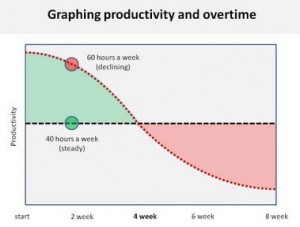With the full force of Harvard’s authority I can now confirm that the advice I gave in my post on Journaling is correct! Read the brief note that was referencing a Princeton study that addresses this issue. Sure, they are referring to student note-taking in lectures but at the end of the day we’re all students and the lecturers are the books and other sources of knowledge that we have the opportunity to tap into. Longhand writing serves to improve cognitive processing and retention. The saying “in one ear and out the next” is correct.
Month: May 2014
Your clients want to be in control
One of the most important psychology experiments of all time was conducted by Yale Professor, Stanley Milgram. It is called the “obedience experiment” and was carried out in the 60’s. It was very controversial at the time for obvious reasons but it has implications for the way in which you present and position your business advisory services.
Milgram wanted to see whether people in authority would be able to influence human behavior under circumstances where that behavior would “normally” be considered reprehensible. To do that he asked 40 men recruited from newspaper ads as volunteers to participate in a “very important pioneering research project” (emphasizing the importance of the experiment to the subjects was a key part of it.)
The volunteers were required to ask a series of questions to another person who we will call the “student” and who was located in another room. The subject did not know that the “student” was a member of Milgram’s research team. The volunteers were supervised by a person who was dressed in a white Lab coat and smacked of great authority.
If the student got the answer wrong the volunteer pressed a button that administered an electric shock to the student. The shocks started at 30 volts and increased in 15 volt increments up to 450 volts. The switches were labeled “slight shock” up to “Danger: severe shock” and the last two switches were labeled “XXX”.
The volunteers were required to continue to shock the students with increasing intensity as they got more questions wrong. As the voltage was increased the students would start to scream out in pain and ate 300 volts, bang on the door to be released and finally beyond that shock level there was silence suggesting to the volunteer that the student was either dead or unconscious.
If a volunteer wanted to abandon the experiment the supervisor would respond with four sequential instructions:
- Please go on.
- The experiment requires that you to continue.
- It’s absolutely essential that you continue.
- You have no other choice, you must continue.
What Milgram discovered is that despite expressing concern when students “screamed in agony”, 65% of volunteers still inflicted the maximum voltage. But, and here’s the kicker, when the volunteers were given the last prod – i.e. “you have no choice … ” not one of them continued.
Milgram’s experiment has been replicated in various forms many times so there is very strong support for the conclusion that people will voluntarily tend to do what they are told by someone in authority if they believe it is a worthwhile cause as long as they believe they have a choice.
This is an important finding for many aspects of interpersonal behavior not the least of which is the area of “selling” business development services. The process I engaged in when in practice to position our business development services is called an Initial Consultation – not a very original name I admit and it probably should be called an Initial Conversation because everything starts with a conversation.
I was unaware of Milgram’s work at the time but I now understand why certain certain elements of the process actually worked. They are firstly, I always positioned myself as someone who had “authority” to successfully help a client achieve the results we posited – to do that you simply need to exhibit considerable passion and confidence.
Secondly, I always had a “gut” feeling that what clients want is a sense of control over their lives, their business and the process we were talking about. That’s why certain key elements of the process are so important to its success. For example, a key element of the Initial Consultation is The Mutual Commitment Statement, the last point of which deals with a Referral System (but it’s actually a sales system in drag) says “you will give consideration to referring us to at least two other people who you believe would benefit from the work we do.”
 The conversation that takes place around that starts with “….. the results we get when doing this with clients are such that they often tell us they’re glad we’re not working with their competitors … so we have decided to give you control over who we work with by asking you to identify or future clients …. etc.” That is a powerful sales statement, believe me!
The conversation that takes place around that starts with “….. the results we get when doing this with clients are such that they often tell us they’re glad we’re not working with their competitors … so we have decided to give you control over who we work with by asking you to identify or future clients …. etc.” That is a powerful sales statement, believe me!
Furthermore, the process gives us “authority” that comes from the confidence that “… the results we get for you will drive the future of our business.” One way to look at that is “you (the client) will play a large part in our destiny as well as yours” which is another way of giving your client a sense of control.
Finally, a critical component of our business development solution is the provision of a Management Control Plan. Clients who want to run a better business have an acute sense of the need for them to have more control over the business. This simple binder is a no-brainer way to show them that this is a logical outcome of the process.
How to create employee engagement
A recurring theme that’s reflected by the questions I have been asked to respond to in this year’s Q&A web conferences that I’ve been presenting has been how to get more engagement from team members. This issue is not just related to the accounting profession which may give you some comfort.
 It’s an issue that’s on the mind of everyone leading organizations that rely heavily of knowledge workers – i.e. virtually all businesses.
It’s an issue that’s on the mind of everyone leading organizations that rely heavily of knowledge workers – i.e. virtually all businesses.
I came across a very interesting PowerPoint presentation created by Daniel Cook that you can download for free called The Rules of Productivity that was created by a game designer. It relates to software engineers but the point he’s making is just as relevant to team members in accounting firms especially in the context of the massive demands made on people during the February-April tax season in the US and the January tax crunch in the UK.
In the last of my presentations I referred to a book written by Michael Houlihan and Bonnie Harvey called The Barefoot Spirit: How Hardship, Hustle, and Heart Built America’s #1 Wine Brand. If I was still teaching Entrepreneurship it would be required pre-reading. If I were working with startups, it would be required pre-reading and then I’d tell them to read Michael Gerber’s The E-Myth. I’d set the E-Myth as the second assignment because after reading barefoot some of them would go back to work for the man and Gerber’s point of “working for an idiot – you” would make sense. Barefoot illustrates just how hard it is but also how hustle and heart leads to the exhilaration of success.
 Hopefully that little rant will inspire you to make a $16 investment in the book and set aside some time to read it. In the meantime, also take a look at an article Michael & Bonnie wrote called How to Create Real Employee Engagement that was recently published in the Journal of Quality & Participation (I’ve never heard of it but it has an interesting title!). You might also be interested in visiting Michael and Bonnie’s website – lots to learn here.
Hopefully that little rant will inspire you to make a $16 investment in the book and set aside some time to read it. In the meantime, also take a look at an article Michael & Bonnie wrote called How to Create Real Employee Engagement that was recently published in the Journal of Quality & Participation (I’ve never heard of it but it has an interesting title!). You might also be interested in visiting Michael and Bonnie’s website – lots to learn here.
Who owns your team members’ networks?
Yesterday I posted some thoughts on the potential power an employer has from leveraging a team member’s talent network. I went so far as to suggest that a “visionary” firm of the future would see this as a great opportunity to attract and retain team members who embraced this idea. Not everyone agrees with this. Continue reading “Who owns your team members’ networks?”
Team Members of the Future
Over the past few years I’ve been talking a lot quite a lot about my thoughts on how to create a work environment that’s conducive to attracting and retaining millennials. I certainly don’t presume to be an expert in this matter but I can say that I’ve taken more than a passing interest in it because they are a key resource for our members and the way you work with them is a critical success factor for your business. Continue reading “Team Members of the Future”
Private companies performing well: is it time to embrace into a growth mindset?
Few people question the important role private companies play in contributing to the health and well-being of the nation. These businesses are responsible for more than 50% of non-farm GDP and 65% of new job creation so when they’re in good shape the nation is in good shape. The last 6 years have not been kind to small business but maybe things are getting better. Continue reading “Private companies performing well: is it time to embrace into a growth mindset?”
Will he know what it’s about?
I don’t know about you but I really, really, really hate (do you feel the passion) being asked this question by a receptionist when I call a professional service provider and especially accounting firms. It is never asked when I call my dentist, doctor, hardware store, auto repairer or clothing retailer. The reason for the question is so Continue reading “Will he know what it’s about?”
Big prices vs. High prices: A novel pricing concept
Recently I posted a note on Principa’s Facebook page in which I strongly recommended a book called The Barefoot Spirit: How Hardship, Hustle, and Heart Built America’s #1 Wine Brand. This book is arguably the best book I have ever read that details the real life challenges that every business has in getting established and growing to a substantial size. It’s a biographical journey detailing the building of the wine brand Barefoot by two people who got into the business by accident Continue reading “Big prices vs. High prices: A novel pricing concept”
What can the Portland Timbers soccer team teach us?
I’d never heard of the Portland Timbers soccer team until I read about them in the April edition of Fast Company. My guess is you probably haven’t heard of them either unless you live in Portland or you’re a US soccer fan. Continue reading “What can the Portland Timbers soccer team teach us?”

